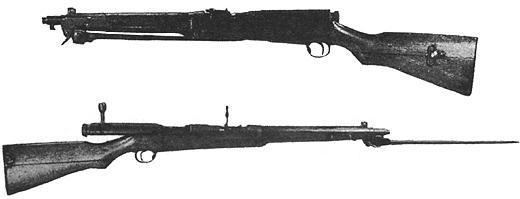Type Cavalry-Carbine In service 1912–1945 Designer Nariakira Arisaka | Place of origin Empire of Japan Used by Imperial Japanese Army | |
 | ||
Wars World War I
Second Sino-Japanese War,
World War II,
Korean War,
Chinese Civil War | ||
The Type 44 Cavalry Rifle (四四式騎銃Yonyon-shiki kijū or Yonjūyon-shiki kijū) is a Japanese bolt-action rifle. This rifle is also often referred to as a Type 44 Carbine.
Contents
History and development
Developed from the Type 38 carbine to provide a cavalryman a carbine with a bayonet and not be encumbered with weapons as before the trooper was required to have a Type 32 cavalry saber, a Type 38 carbine and a bayonet. It entered production in 1911 and entered service in 1912 (the 44th year of the Meiji period, hence "Type 44"), and served on until the end of the Second World War in 1945, production of the rifle ran until three years prior to the end of the Second World War; 1942. Approximately 91,900 Type 44 rifles were produced by Japanese arsenals during these years.
Although it was intended for cavalry troops, many other units such as transportation units were issued these carbines and some cavalry troops continued to use the Type 38 carbine.
After the war, the Type 44 continued to be used by the Chinese People's Liberation Army and Navy.
Description and variant types
It was a development of the Arisaka Type 38 Cavalry Rifle, the main difference being the bayonet is a needle type and it can be folded backwards and locks underneath the barrel. A hook was located directly below the front sight on the right side of the rifle, replicating the hooked quillon of the Type 30 bayonet for use in the bayonet fencing techniques taught to Japanese soldiers of the period. The Type 44 also included a compartment in the buttstock for which to store a unique two-piece cleaning rod. The cleaning rod storage compartment was accessed via an ingenious rotating door. It fired the 6.5×50mm Arisaka round, and capacity was an internal five-round box magazine, it was fed via five-round chargers.
The Type 44 was produced in three variations (referred to as First, Second, and Third variations). The major differences between variations was in the folding bayonet housing, which increased the length and durability with each variation. The changes to the bayonet housing was because of accuracy issues and to strengthen the stock. A minor difference between variations may be found in the cleaning rod compartment found beneath the buttplate. First variation stocks had two holes drilled for each half of the cleaning rod, while second and third variations had a single larger hole to house both halves of the cleaning rod.
